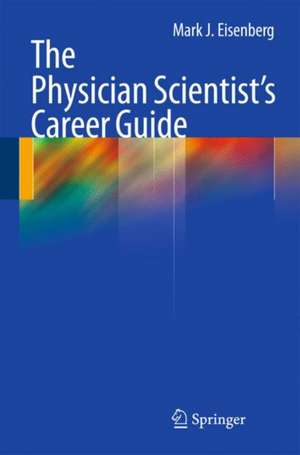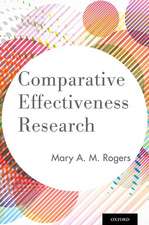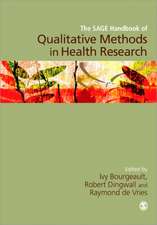The Physician Scientist's Career Guide
Autor Mark J. Eisenbergen Limba Engleză Paperback – 26 oct 2010
Preț: 736.39 lei
Preț vechi: 775.14 lei
-5% Nou
Puncte Express: 1105
Preț estimativ în valută:
140.90€ • 147.54$ • 116.87£
140.90€ • 147.54$ • 116.87£
Carte tipărită la comandă
Livrare economică 10-24 aprilie
Preluare comenzi: 021 569.72.76
Specificații
ISBN-13: 9781603279079
ISBN-10: 1603279075
Pagini: 272
Ilustrații: XXIV, 272 p. 1 illus.
Dimensiuni: 155 x 235 x 16 mm
Greutate: 0.93 kg
Ediția:2011
Editura: Springer Us
Colecția Springer
Locul publicării:New York, NY, United States
ISBN-10: 1603279075
Pagini: 272
Ilustrații: XXIV, 272 p. 1 illus.
Dimensiuni: 155 x 235 x 16 mm
Greutate: 0.93 kg
Ediția:2011
Editura: Springer Us
Colecția Springer
Locul publicării:New York, NY, United States
Public țintă
Professional/practitionerCuprins
I. BACKGROUND
Chapter 1 Is a Physician-Scientist career right for you?
a. What is a Physician-Scientist?
b. Are you suited for the career of a Physician-Scientist?
c. Statistics regarding the current status of the profession
Chapter 2 How to become a Physician-Scientist
a. Basic career trajectory
b. Career paths
Chapter 3 Getting started
a. Choosing a research training program
b. Tips for applying to training programs
c. Choosing a research group/laboratory and mentor
d. Choosing a thesis topic
e. Writing (papers, meta-analyses, review articles)
f. What to avoid
II. LAUNCHING A PHYSICIAN-SCIENTIST CAREER
Chapter 4 Getting your first job
a. Where to look for jobs
b. Types of positions
c. The academic CV
d. Interviewing
e. Negotiation
Chapter 5 You've got the job, now what?
a. Identifying a research topic
b. Establishing a research team and collaborations
c. Setting up an office and research laboratory
III. BUILDING A SUCCESSFUL CAREER AS A PHYSICIAN-SCIENTIST
Chapter 6 Biomedical writing
a. Tips for successful medical writing
b. Resources
Chapter 7 Abstracts
a. Writing abstracts
b. Submitting abstracts
Chapter 8 Articles and Publications
a. How to pick a topic
b. Manuscript writing
c. How to choose a journal
d. Dealing with journals
Chapter 9 Getting funded
a. Identifying a fundable topic
b. Choosing the right funding agency
c. Putting together a supportable budget
d. Putting together the right team
e. Selecting the right committee
f. Renewals
g. An insider's tips
Chapter 10 The how-to's of successful grant writing
a. Types of grants
b. Components of a grant
c. Strategies
Chapter 11 Salary support
a. Types of salary support
b. Funding sources
c. Applying for salary support
d. An insider's tips
Chapter 12 Pharmaceutical industry
a. Pharmaceutical companies and industry relations
b. Funding
c. Devices
IV. KEEPING THE PHYSICIAN-SCIENTIST CAREER ON TRACK
Chapter 13 Promotions
a. Tenure track
b. Assistant Professor
c. Associate Professor
d. Full Professor
e. Emeritus Professor
Chapter 14 Managing your research team
a. Hiring staff
b. Managing your staff
Chapter 15 Managing your research funds
Chapter 16 Managing your time
a. Peer reviews
b. Editorial boards
c. Grant reviews
d. Committees
e. Professional organizations
f. Scientific and professional meetings
Chapter 17 Teaching
a. Academic courses
b. Continuing Medical Education
c. Supervising (research)
d. Clinical teaching
e. Other research-related teaching
Chapter 18 Mentorship
a. Finding mentors
b. Being a mentor
Chapter 19 Lectures and presentations
a. Academic seminars
b. Scientific and professional presentations
c. Industry events
Chapter 20 Women in academic medicine
a. Current status and statistics
b. Challenges
c. Solutions
V. PARTING WORDS OF ADVICE
Chapter 21 Useful resources
a. Professional organizations and societies
b. Funding agencies
c. Books
d. Websites
Chapter 22 Conclusion
a. Recap
b. Value of the Physician-Scientist
References
Chapter 1 Is a Physician-Scientist career right for you?
a. What is a Physician-Scientist?
b. Are you suited for the career of a Physician-Scientist?
c. Statistics regarding the current status of the profession
Chapter 2 How to become a Physician-Scientist
a. Basic career trajectory
b. Career paths
Chapter 3 Getting started
a. Choosing a research training program
b. Tips for applying to training programs
c. Choosing a research group/laboratory and mentor
d. Choosing a thesis topic
e. Writing (papers, meta-analyses, review articles)
f. What to avoid
II. LAUNCHING A PHYSICIAN-SCIENTIST CAREER
Chapter 4 Getting your first job
a. Where to look for jobs
b. Types of positions
c. The academic CV
d. Interviewing
e. Negotiation
Chapter 5 You've got the job, now what?
a. Identifying a research topic
b. Establishing a research team and collaborations
c. Setting up an office and research laboratory
III. BUILDING A SUCCESSFUL CAREER AS A PHYSICIAN-SCIENTIST
Chapter 6 Biomedical writing
a. Tips for successful medical writing
b. Resources
Chapter 7 Abstracts
a. Writing abstracts
b. Submitting abstracts
Chapter 8 Articles and Publications
a. How to pick a topic
b. Manuscript writing
c. How to choose a journal
d. Dealing with journals
Chapter 9 Getting funded
a. Identifying a fundable topic
b. Choosing the right funding agency
c. Putting together a supportable budget
d. Putting together the right team
e. Selecting the right committee
f. Renewals
g. An insider's tips
Chapter 10 The how-to's of successful grant writing
a. Types of grants
b. Components of a grant
c. Strategies
Chapter 11 Salary support
a. Types of salary support
b. Funding sources
c. Applying for salary support
d. An insider's tips
Chapter 12 Pharmaceutical industry
a. Pharmaceutical companies and industry relations
b. Funding
c. Devices
IV. KEEPING THE PHYSICIAN-SCIENTIST CAREER ON TRACK
Chapter 13 Promotions
a. Tenure track
b. Assistant Professor
c. Associate Professor
d. Full Professor
e. Emeritus Professor
Chapter 14 Managing your research team
a. Hiring staff
b. Managing your staff
Chapter 15 Managing your research funds
Chapter 16 Managing your time
a. Peer reviews
b. Editorial boards
c. Grant reviews
d. Committees
e. Professional organizations
f. Scientific and professional meetings
Chapter 17 Teaching
a. Academic courses
b. Continuing Medical Education
c. Supervising (research)
d. Clinical teaching
e. Other research-related teaching
Chapter 18 Mentorship
a. Finding mentors
b. Being a mentor
Chapter 19 Lectures and presentations
a. Academic seminars
b. Scientific and professional presentations
c. Industry events
Chapter 20 Women in academic medicine
a. Current status and statistics
b. Challenges
c. Solutions
V. PARTING WORDS OF ADVICE
Chapter 21 Useful resources
a. Professional organizations and societies
b. Funding agencies
c. Books
d. Websites
Chapter 22 Conclusion
a. Recap
b. Value of the Physician-Scientist
References
Recenzii
From the reviews:
“This book defines a path that the author suggests is likely to lead to a successful and fulfilling career as a physician-scientist. … The audience includes medical students, residents, fellows, and junior faculty members. … The book is well written and easy to read and it has useful information for academicians who are not interested in research careers. … Overall, this book should be part of an institution’s library … .” (Marion C. Cohen, Doody’s Review Service, February, 2011)
“The guide is directed toward the young physician just starting out in a research career, it offers sound and sensible advice for those at any stage in their careers. The book is divided into 4 sections, along with relevant appendices and a useful index. … readers excited by the possibility of combining the activities of being both a physician and a dedicated clinical scientist, at any career stage, will find The Physician Scientist’s Career Guide the book for them.” (A. Mark Clarfield, Journal of the American Medical Association, Vol. 306 (9), September, 2011)
“This book defines a path that the author suggests is likely to lead to a successful and fulfilling career as a physician-scientist. … The audience includes medical students, residents, fellows, and junior faculty members. … The book is well written and easy to read and it has useful information for academicians who are not interested in research careers. … Overall, this book should be part of an institution’s library … .” (Marion C. Cohen, Doody’s Review Service, February, 2011)
“The guide is directed toward the young physician just starting out in a research career, it offers sound and sensible advice for those at any stage in their careers. The book is divided into 4 sections, along with relevant appendices and a useful index. … readers excited by the possibility of combining the activities of being both a physician and a dedicated clinical scientist, at any career stage, will find The Physician Scientist’s Career Guide the book for them.” (A. Mark Clarfield, Journal of the American Medical Association, Vol. 306 (9), September, 2011)
Textul de pe ultima copertă
The Physician Scientist’s Career Guide provides a complete guide to having a successful career as a Physician Scientist. Filled with first-hand experiences and practical advice, it guides readers through each step of this career path, from choosing a degree and training program, to navigating the tenure track, and through the intricacies of applying for and obtaining funding. The volume is unique in that it provides an overview of this entire career path, allowing readers to envision and prepare for their futures.The Physician Scientist’s Career Guide fulfills a unique and crucial need and is an invaluable guide for medical students, fellows and newly appointed faculty members interested in a career in research.
Caracteristici
Presents an overview of the entire career path Broad range of topics addressed Includes supplementary material: sn.pub/extras












